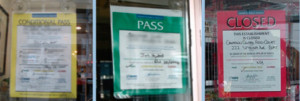“We put our children and our parents and people who are ill in these institutions,” said Canadian food safety expert Doug Powell. “We’ve got captive the most vulnerable people, and if there isn’t ![]() going to be a high level of food safety there where will you find it?”
going to be a high level of food safety there where will you find it?”
Sort of a garbled quote, but valid.
In an accompanying story, I said, “All outbreaks should be documented so residents and their families can figure out if there are repeat offenders out there to stay away from.”
Restaurant disclosure icon Robert Cribb of the Toronto Star and a team of students from Ryerson University found that 12 years after the introduction of Toronto’s red-yellow-green DineSafe disclosure program, food inspection records for nursing homes, hospitals, daycares and school cafeterias were never publicly reported.
In June, shortly after the Ryerson/Star investigation, Toronto Public Health began releasing a two-year history of inspection results online.
“You guys get the credit for pushing us to disclose,” said Toronto Public Health food safety manager Jim Chan. “The questions  regarding disclosure of the institutions played a role in this.”
regarding disclosure of the institutions played a role in this.”
While the information is now gradually moving online, the institutions, which are provincially licensed, will still not be subject to the city bylaw that compels restaurants to post green, yellow or red signs at their entrances indicating their latest inspection results.
The public has to hunt the information online on the DineSafe website.
The feature has many examples of shoddy food safety in places for our most vulnerable. Check it out at http://www.thestar.com/news/canada/2013/08/14/ontario_to_open_up_toronto_institutions_foodsafety_records.html.

.jpg) displayed at business premises.
displayed at business premises..png) currently have a written procedure for food hygiene. Whilst the business premises could be spotless, without this written supporting document they could not be scored above a one-star rating. It is important to note that those premises with low ratings are most likely to be in the process of improving."
currently have a written procedure for food hygiene. Whilst the business premises could be spotless, without this written supporting document they could not be scored above a one-star rating. It is important to note that those premises with low ratings are most likely to be in the process of improving."